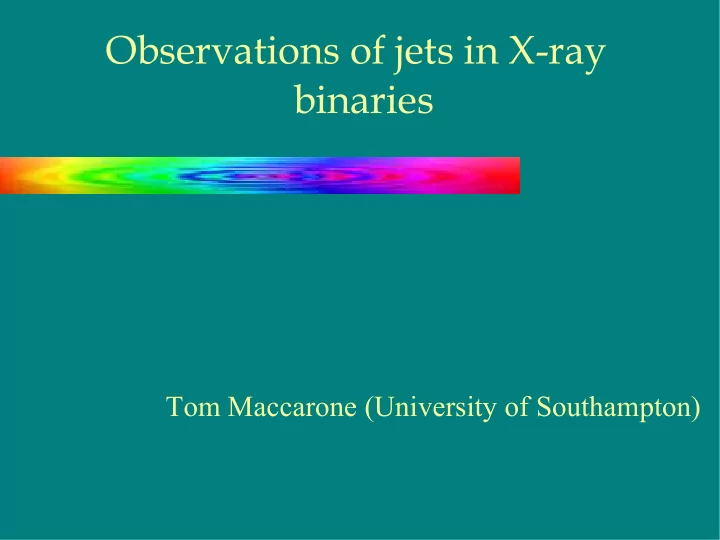

Observations of jets in X-ray binaries Tom Maccarone (University of Southampton)
ING archive/Nick Szymanek Russell et al. 2007 Stirling et al. 2001
Black Hole X-ray binaries: key sources for understanding accretion-ejection phenomenology ● Strong source variability ● Variability on accessible timescales ● Moderately bright radio sources ● Relatively small mass range ● Simple systems – no boundary layers or surface magnetic fields GRO J1655-40 RXTE light curve
Spectral States - SEDs data from Miller et al. (2001) for XTE J 1748-288 •
Variability and states Power spectra from van der Klis (2006)
Low/hard state ● Characterized by cutoff power law spectrum, well modeled by thermal Comptonization (Thorne & Price 1975) ● Strong, broadband aperiodic variability ● Debate over geometry - “sphere+disk” or corona above a disk
High/soft state ● Well modeled by multi-color blackbody models – i.e. standard Shakura & Sunyaev (1973)/Novikov & Thorne (1973) disks, sometimes with weak power law tails ● Very little variability seen at any frequency, and what's seen is probably driven by the power law
Intermediate states ● At transitions, intermediate states exist ● in a few very bright sources, they can be long lived, and are called very high states ● Spectra intermediate between low/hard and high/soft states ● Variability roughly intermediate, except for strong, relatively high Q quasi-periodic oscillations which are often seen in transitions, but not in the other states
When are different states seen? HS -> LS transition – always near 2% of Eddington (Maccarone 2003) LS-> HS transition – luminosity seems to depend on size of accretion disk (Shahbaz, Charles & King 1998; Portegies Zwart, Dewi & Maccarone 2005) from van der Klis (2006)
SS Cyg – from McGowan et al. (2003) black hole transients from Maccarone & Coppi 2003 Aql X-1, from M&C 2003
When are jets seen (and not seen)? ● Steady jets seen in low/hard states ● Seen as transient, high luminosity, highly relativistic episodes in hard very high states ● "Quenched" in high/soft states (Tananbaum et al. 1972; Harmon et al. 1995; Fender et al. 1999)
from Fender et al. 1999
Jet Properties in Low/Hard State ● Radio luminosity correlates with X-ray luminosity in low/hard state ● L r α L x 0.7 (Corbel et al. 2003; Gallo, Fender & Pooley 2003) only Cygnus X-1 has been imaged ● Flat radio spectrum (i.e. f ν approx constant) with break typically in the infrared
Jet-disk coupling in the low/hard state from Gallo, Fender & Pooley (2003)
Jet Properties in Intermediate states Transient, "bullet-like" episodes often seen ● Sometimes very highly extended ● Where spectra are measured, usually, but not always, ● steep spectrum (i.e. f ν ~ ν -0.7 ) Sometimes seen in X-rays ● Apparent superluminal motions can imply β >0.9 in several ● cases (e.g. Mirabel & Rodriguez 1994; Hjellming & Rupen 1995) External shocks against low state jet? (Vadawale et al. ● 2001; Fender, Belloni & Gallo 2003)
The Extended Jet from XTE J1550-564 figure from Tomsick et al. (2003)
Neutron star jets Fainter than black holes when hard ● X-rays are strong Open:BH consistent with square of black ● Closed:NS hole relation, implying advection in black holes (Koerding et al. 2006) Brighter than black holes in soft ● states not yet well understood ● Some data from ultracompact ● X-ray binaries. Is this important? Seen only from low B neutron stars ● (i.e. not HMXB pulsars) from Migliari & Fender 2006
Some speculation Boundary layers: the key to “soft state” jets? ● Seen in the bright neutron stars, supersoft sources, and T Tauri ● stars, and also recent SS Cyg radio observation Not seen in black holes ● The “central energy source” of Livio (1999)? ● or, a way to generate large scale height magnetic fields ● without a geometrically thick disk? Or, magnetic field of neutron star/WD seeds jet production? ●
Jet kinetic power Upper limit can come from state transitions ● Luminosity is continuous across state transitions, so kinetic power at the ● transition cannot be large compared to radiative power (Maccarone 2005) Lower limit from multiple methods ● Equipartition of energy in jets ● Odd coupling of optical and X-ray variability in XTE J 1118+480 (Malzac, ● Merloni & Fabian 2004) Roughly equal jet kinetic power and total accretion flow radiative ● power at state transition Seems to be true in neutron star systems as well, and even in ● SS Cyg (various papers by Koerding et al)
Conclusions ● X-ray binaries provide an important probe of accretion in general There are dimensions of the problem of jet formation accessible from observations of X- ● ray binaries, but not observations of AGN Long timescale variability, effects of solid surfaces, effects of different chemical ● composition of materials ● Most stellar mass black hole sources fit a well-defined pattern for jet behavior as a function of X-ray source behavior; Low B neutron stars follow this pattern less well, high B neutron stars are completely different, data on white dwarfs is quite spotty ● Solid surfaces may help promote jet formation in some cases, harm formation in others
Recommend
More recommend